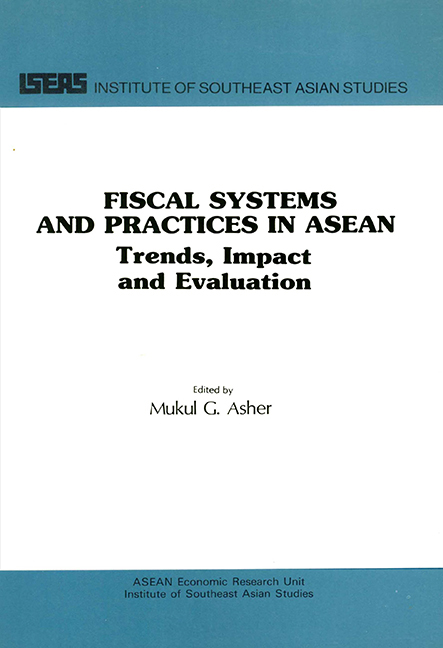Book contents
- Frontmatter
- Contents
- List of Tables
- List of Figures
- Acknowledgements
- 1 A Comparative Overview of ASEAN Fiscal Systems an Practices
- 2 Fiscal System and Practices in Indonesia
- 3 Fiscal System and Practices in Malaysia
- 4 Fiscal System and Practices in the Philippines
- 5 Fiscal System and Practices in Singapore
- 6 Fiscal System and Practices in Thailand
- THE EDITOR
2 - Fiscal System and Practices in Indonesia
Published online by Cambridge University Press: 21 October 2015
- Frontmatter
- Contents
- List of Tables
- List of Figures
- Acknowledgements
- 1 A Comparative Overview of ASEAN Fiscal Systems an Practices
- 2 Fiscal System and Practices in Indonesia
- 3 Fiscal System and Practices in Malaysia
- 4 Fiscal System and Practices in the Philippines
- 5 Fiscal System and Practices in Singapore
- 6 Fiscal System and Practices in Thailand
- THE EDITOR
Summary
Introduction
Fiscal policies, that is, policies concerning the size and the structure of the government budget, along with other economic policies, such as monetary and balance of payments policies, are used by governments to pursue various economic objectives. According to the Outline of the State Guidelines (Garis-Garis Besar Haluan Negara or GBHN), as decreed by the People's Assembly (Majelis Permusyawaratan Rakyat, or MPR), the objectives of development in Indonesia are as follows: (a) to preserve economic, political and social stability; (b) to equalize the costs as well as the benefits of economic development; and (c) to pursue a rapid rate of economic growth. Every five years, during the first deliberations after being elected, the MPR sets an Outline of the State Guidelines as the basis for the government of the newly elected President in drawing its programmes, including the Five-year Development Plan (Repelita). Under the presidential system established under the present 1945 Constitution, the President is the Head of State, the Head of Executive Government as well as the sole mandatary to implement the decrees of the People's Assembly. The Five-year Development Plan is an indicative plan which establishes national development priorities to provide the basis for allocating public sector investment and to give guidance to the private sector.
Originally, the government's budget was intended to be an annual implementation of the five-year plans. In reality, however, the co-ordination between the two has been lacking. This is because, since the first “oil shock” in 1973-74, the government's realized revenues (both oil and non-oil) have always exceeded the targeted revenues. As a result, fiscal projections of the first three five-year plans have been made obsolete.
The public sector in Indonesia consists of three major institutions, namely, the central government, state enterprises and semi-autonomous agencies, such as the National Logistic Agency (Bulog), and the local governments. This study, however, covers only the financial transactions of the central government.
Information
- Type
- Chapter
- Information
- Fiscal System and Practices in ASEANTrends, Impact and Evaluation, pp. 19 - 62Publisher: ISEAS–Yusof Ishak InstitutePrint publication year: 1989
